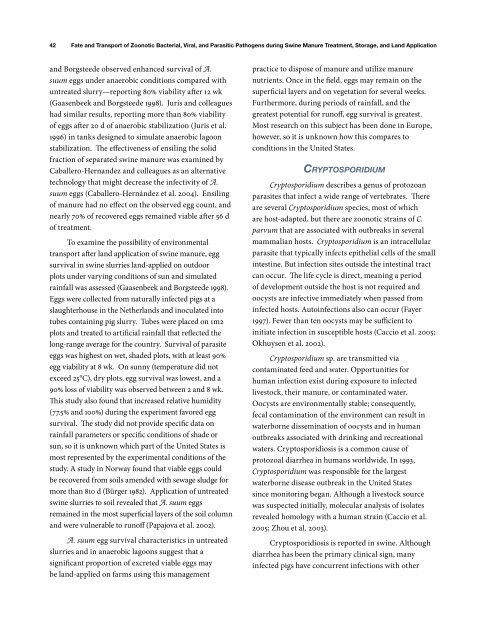Fate and Transport of Zoonotic Bacterial, Viral, and - The Pork Store ...
Fate and Transport of Zoonotic Bacterial, Viral, and - The Pork Store ...
Fate and Transport of Zoonotic Bacterial, Viral, and - The Pork Store ...
You also want an ePaper? Increase the reach of your titles
YUMPU automatically turns print PDFs into web optimized ePapers that Google loves.
42<br />
<strong>Fate</strong> <strong>and</strong> <strong>Transport</strong> <strong>of</strong> <strong>Zoonotic</strong> <strong>Bacterial</strong>, <strong>Viral</strong>, <strong>and</strong> Parasitic Pathogens during Swine Manure Treatment, Storage, <strong>and</strong> L<strong>and</strong> Application<br />
<strong>and</strong> Borgsteede observed enhanced survival <strong>of</strong> A.<br />
suum eggs under anaerobic conditions compared with<br />
untreated slurry—reporting 80% viability after 12 wk<br />
(Gaasenbeek <strong>and</strong> Borgsteede 1998). Juris <strong>and</strong> colleagues<br />
had similar results, reporting more than 80% viability<br />
<strong>of</strong> eggs after 20 d <strong>of</strong> anaerobic stabilization (Juris et al.<br />
1996) in tanks designed to simulate anaerobic lagoon<br />
stabilization. <strong>The</strong> effectiveness <strong>of</strong> ensiling the solid<br />
fraction <strong>of</strong> separated swine manure was examined by<br />
Caballero-Hern<strong>and</strong>ez <strong>and</strong> colleagues as an alternative<br />
technology that might decrease the infectivity <strong>of</strong> A.<br />
suum eggs (Caballero-Hernández et al. 2004). Ensiling<br />
<strong>of</strong> manure had no effect on the observed egg count, <strong>and</strong><br />
nearly 70% <strong>of</strong> recovered eggs remained viable after 56 d<br />
<strong>of</strong> treatment.<br />
To examine the possibility <strong>of</strong> environmental<br />
transport after l<strong>and</strong> application <strong>of</strong> swine manure, egg<br />
survival in swine slurries l<strong>and</strong>-applied on outdoor<br />
plots under varying conditions <strong>of</strong> sun <strong>and</strong> simulated<br />
rainfall was assessed (Gaasenbeek <strong>and</strong> Borgsteede 1998).<br />
Eggs were collected from naturally infected pigs at a<br />
slaughterhouse in the Netherl<strong>and</strong>s <strong>and</strong> inoculated into<br />
tubes containing pig slurry. Tubes were placed on 1m2<br />
plots <strong>and</strong> treated to artificial rainfall that reflected the<br />
long-range average for the country. Survival <strong>of</strong> parasite<br />
eggs was highest on wet, shaded plots, with at least 90%<br />
egg viability at 8 wk. On sunny (temperature did not<br />
exceed 25°C), dry plots, egg survival was lowest, <strong>and</strong> a<br />
90% loss <strong>of</strong> viability was observed between 2 <strong>and</strong> 8 wk.<br />
This study also found that increased relative humidity<br />
(77.5% <strong>and</strong> 100%) during the experiment favored egg<br />
survival. <strong>The</strong> study did not provide specific data on<br />
rainfall parameters or specific conditions <strong>of</strong> shade or<br />
sun, so it is unknown which part <strong>of</strong> the United States is<br />
most represented by the experimental conditions <strong>of</strong> the<br />
study. A study in Norway found that viable eggs could<br />
be recovered from soils amended with sewage sludge for<br />
more than 810 d (Bürger 1982). Application <strong>of</strong> untreated<br />
swine slurries to soil revealed that A. suum eggs<br />
remained in the most superficial layers <strong>of</strong> the soil column<br />
<strong>and</strong> were vulnerable to run<strong>of</strong>f (Papajova et al. 2002).<br />
A. suum egg survival characteristics in untreated<br />
slurries <strong>and</strong> in anaerobic lagoons suggest that a<br />
significant proportion <strong>of</strong> excreted viable eggs may<br />
be l<strong>and</strong>-applied on farms using this management<br />
practice to dispose <strong>of</strong> manure <strong>and</strong> utilize manure<br />
nutrients. Once in the field, eggs may remain on the<br />
superficial layers <strong>and</strong> on vegetation for several weeks.<br />
Furthermore, during periods <strong>of</strong> rainfall, <strong>and</strong> the<br />
greatest potential for run<strong>of</strong>f, egg survival is greatest.<br />
Most research on this subject has been done in Europe,<br />
however, so it is unknown how this compares to<br />
conditions in the United States.<br />
cr y p t o s p o r i d i u m<br />
Cryptosporidium describes a genus <strong>of</strong> protozoan<br />
parasites that infect a wide range <strong>of</strong> vertebrates. <strong>The</strong>re<br />
are several Cryptosporidium species, most <strong>of</strong> which<br />
are host-adapted, but there are zoonotic strains <strong>of</strong> C.<br />
parvum that are associated with outbreaks in several<br />
mammalian hosts. Cryptosporidium is an intracellular<br />
parasite that typically infects epithelial cells <strong>of</strong> the small<br />
intestine. But infection sites outside the intestinal tract<br />
can occur. <strong>The</strong> life cycle is direct, meaning a period<br />
<strong>of</strong> development outside the host is not required <strong>and</strong><br />
oocysts are infective immediately when passed from<br />
infected hosts. Autoinfections also can occur (Fayer<br />
1997). Fewer than ten oocysts may be sufficient to<br />
initiate infection in susceptible hosts (Caccio et al. 2005;<br />
Okhuysen et al. 2002).<br />
Cryptosporidium sp. are transmitted via<br />
contaminated feed <strong>and</strong> water. Opportunities for<br />
human infection exist during exposure to infected<br />
livestock, their manure, or contaminated water.<br />
Oocysts are environmentally stable; consequently,<br />
fecal contamination <strong>of</strong> the environment can result in<br />
waterborne dissemination <strong>of</strong> oocysts <strong>and</strong> in human<br />
outbreaks associated with drinking <strong>and</strong> recreational<br />
waters. Cryptosporidiosis is a common cause <strong>of</strong><br />
protozoal diarrhea in humans worldwide. In 1993,<br />
Cryptosporidium was responsible for the largest<br />
waterborne disease outbreak in the United States<br />
since monitoring began. Although a livestock source<br />
was suspected initially, molecular analysis <strong>of</strong> isolates<br />
revealed homology with a human strain (Caccio et al.<br />
2005; Zhou et al. 2003).<br />
Cryptosporidiosis is reported in swine. Although<br />
diarrhea has been the primary clinical sign, many<br />
infected pigs have concurrent infections with other


